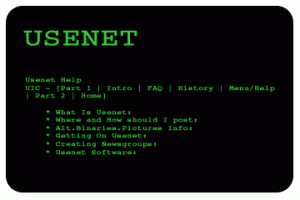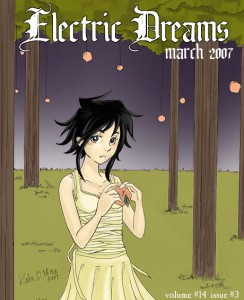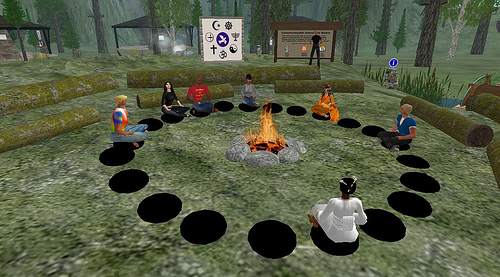Dreamers have a reputation for being Luddites. The truth is that dedicated dream professionals were tapping the power of the web long before Google was a verb. As the Internet has become increasingly intermeshed with our daily lives, it’s useful to look back at the innovations and disappointments of the original online dream-weavers.
So here are my favorite highlights in the history of online dreamwork:
 Bulletin Boards and USENET. Dream researchers and enthusiasts were exploring modem-to-computer bulletin boards for dream sharing as early as the 1980s, when Internet tubes were still made out of wood chips. Later, in 1991, Jack Campin set up a news group for dreamers on USENET, which was one of the first ways to share information and files between computers and servers without having to coordinate with other users “in real time.”
Bulletin Boards and USENET. Dream researchers and enthusiasts were exploring modem-to-computer bulletin boards for dream sharing as early as the 1980s, when Internet tubes were still made out of wood chips. Later, in 1991, Jack Campin set up a news group for dreamers on USENET, which was one of the first ways to share information and files between computers and servers without having to coordinate with other users “in real time.”
Some of these newsgroups are still available today (most people subscribe and get new information in a newsreader), but they are losing prominence, especially as Internet service providers (such as Comcast) are beginning to turn their back on free USENET access. One popular newgroup that still sees some activity is alt.dreams.lucid. You can access it the old fashioned-way (choose your newsgroup application) or go to google groups which has backlogged the last 20 years of USENET activity. Beware – these forums are not closely moderated anymore and tend to be choked with spam. Intrepid web archaeologists can find some goodies tho.
 Electric Dreams. Ever since Al Gore invented the Internet, this online magazine pioneered the sharing of dreams online. Thanks go to Richard Wilkerson for his tireless work in promoting and managing this vast resource. While the community aspects of this site are no longer active, hundreds of dreams articles are still available today here.
Electric Dreams. Ever since Al Gore invented the Internet, this online magazine pioneered the sharing of dreams online. Thanks go to Richard Wilkerson for his tireless work in promoting and managing this vast resource. While the community aspects of this site are no longer active, hundreds of dreams articles are still available today here.
The founders of Electric Dreams worked out the strong ethics that are essential for any kind of dream work, but are especially important for quasi-public spaces like the Internet where privacy issues are provisional at best. These ethical considerations are still valid today; a good run down can be found here.
Jeremy Taylor’s Dream show. Undoubtedly, the greatest press for online dreamwork was “the Dream Show” sponsored by AOL between 1996-1997. Taylor discussed and interpreted dreams to an increasingly large audience of dreamers, and the Dreamshow also had a very popular 24 hour chatroom that became a cultural phenomenon in its own right.
The show was cancelled when Jeremy Taylor refused to follow AOL’s attempt to cash in on the neediest of dreamers by withholding interpretations until they pay additional fees. Although this was the end of the most popular Internet dream work show, Taylor displayed for the world how core ethics in dreamwork cannot be bought or sold. Hats off!
John Herbert’s Dissertation. In 2000, Herbert’s dissertation for Saybrook Graduate School concluded that online dream sharing can provide more insight than traditional dream sharing methods. On the other hand, emotional interplay is reduced. Presumably, this effect is due to the psychological distance created because Internet dream-sharers sit alone at their computers and may take more time to reflect before weighing in with their opinions. Herbert’s findings alleviate much of the earlier fears of dreamworkers that computer-mediated work would be ineffective. For more of Herbert’s important findings and their relevance to online dreamwork, check out this introduction.
CyberDreamWork. Researcher Robert Bosnak is a great example of how to do it right. He successfully lead online dreamwork for over a decade. Bosnak also developed some biofeedback techniques that continue Carl Jung’s work with dreams and lie detector tests, but more recently is known for his online “cyberdreamwork” training.
The Future of Online Dreaming?

Ironically, the trend for peer-to-peer dream sharing on the Internet is in a historic low spot. While certain aspects of dream sharing are still very active (such as lucid dreaming forums), most people these days do searches on the web to find canned dream interpretation. I smell an untapped opportunity, especially as social networking sites like Myspace and Facebook are integrating with multi-media applications like podcasting and video conferencing.
And then there’s the maturation of virtual worlds like Second Life (which is debatable – usage is down, porn avatars are on the rise, but businesses are getting involved and so are other special interest groups). When I spoke to veteran cyberdreamer Richard Wilkerson recently, he mused that dream sharing on Second Life could prove to be pretty entertaining. Provided that the right balance of ethics, anonymity and sensitivity from expert guidance is met, the next chapter in online dream work is ripe for the picking.
If, for research purposes, you are interested in a more in-depth look into the history of online dreamwork, Wilkerson has produced an infomative CD that is out-of-print but the product review on Amazon has a detailed timeline.
To get involved with an online dream sharing group now, I recommend the IASD’s private group on Facebook. It is actively moderated by certified dreamworkers and abides by the dream ethics put in place by the International Association for the Study of Dreams.